
Paul Joseph Goebbels was a German Nazi politician and Reich Minister of Propaganda of Nazi Germany from 1933 to 1945. He was one of Adolf Hitler's closest and most devoted associates, and was known for his skills in public speaking and his deeply virulent antisemitism, which was evident in his publicly voiced views. He advocated progressively harsher discrimination, including the extermination of the Jews in the Holocaust.

Alfred Ernst Christian Alexander Hugenberg was an influential German businessman and politician. He was leading figure in nationalist politics in Germany for the first few decades of the twentieth century, and became the country's leading media proprietor during the inter-war period. As leader of the German National People's Party he was instrumental in helping Adolf Hitler become Chancellor of Germany and served in his first cabinet in 1933, hoping to control Hitler and use him as his "tool." Those plans backfired, and by the end of 1933 Hugenberg had been pushed to the sidelines. Although Hugenberg continued to serve as a "guest" member of the Reichstag until 1945, he wielded no political influence.
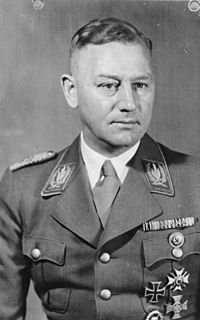
Viktor Lutze was a German Nazi Party functionary and the commander of the Sturmabteilung ("SA") succeeding Ernst Röhm as Stabschef and Reichsleiter. He died from injuries received in a car accident. Lutze was given an elaborate state funeral in Berlin on 7 May 1943.
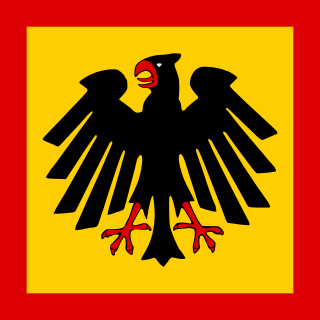
The Reichspräsident was the German head of state under the Weimar constitution, which was officially in force from 1919 to 1945. In English he was usually simply referred to as the President of Germany. The German title Reichspräsident literally means President of the Reich.
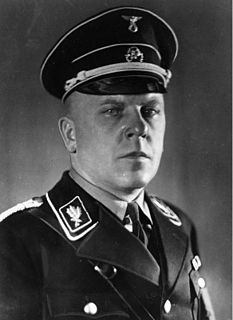
Max Amann was a German politician, businessman and a high-ranking member of the Nazi Party. He was the first business manager of the Nazi Party and later became the head of Eher Verlag, the official Nazi Party publishing house. After the war ended, Amann was arrested by Allied troops. Amann was deemed a Hauptschuldiger and sentenced to ten years in a labour camp. He was released in 1953. Amann died in poverty in Munich.
This Weimar Timeline charts the chronology of the Weimar Republic, dating the pre-history before the adoption of the actual Weimar constitution. This timeline stops when Hitler establishes the Third Reich.
The early timeline of Nazism begins with its origins and continues until Hitler's rise to power.

Hans Heinrich Lammers was a German jurist and prominent Nazi politician. From 1933 until 1945 he served as Chief of the Reich Chancellery under Adolf Hitler. During the 1948–1949 Ministries Trial, Lammers was found guilty of war crimes and crimes against humanity and sentenced to 20 years' imprisonment.

The 1932 German presidential election was held on 13 March, with a runoff round on 10 April. Independent incumbent Paul von Hindenburg won a second seven year term against Adolf Hitler of the National Socialist German Workers Party (NSDAP). Communist Party (KPD) leader Ernst Thälmann also ran and received more than ten percent of the vote in the runoff. Der Stahlhelm deputy leader Theodor Duesterberg ran in the first round but dropped out of the runoff. This was the second and final direct election to the office of President of the Reich (Reichspräsident), Germany's head of state under the Weimar Republic.

Prince August Wilhelm Heinrich Günther Viktor of Prussia, called "Auwi", was the fourth son of Wilhelm II, German Emperor by his first wife, Augusta Victoria of Schleswig-Holstein. He was a vocal supporter of Nazism and of Adolf Hitler.
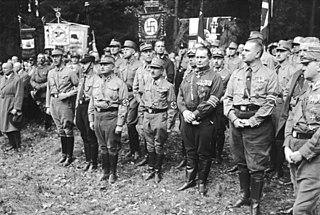
The Harzburg Front was a short-lived radical right-wing, anti-democratic political alliance in Weimar Germany, formed in 1931 as an attempt to present a unified opposition to the government of Chancellor Heinrich Brüning. It was a coalition of the national conservative German National People's Party (DNVP) under millionaire press-baron Alfred Hugenberg with Adolf Hitler's National Socialist German Workers' Party (NSDAP), the leadership of Der Stahlhelm paramilitary veterans' association, the Agricultural League and the Pan-German League organizations.
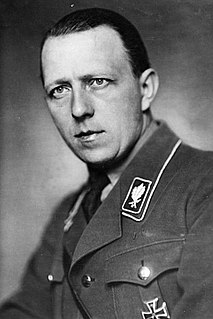
Wolf-Heinrich Julius Otto Bernhard Fritz Hermann Ferdinand Graf von Helldorff was a German police official and politician, who served as a Member of the Landtag of Prussia during the Weimar Republic, as a Member of the Reichstag for the Nazi Party from 1933, and as Ordnungspolizei Chief of Police in Berlin. From 1938, the Graf became associated with the anti-Nazi resistance, and was executed in 1944 for his role in the 20th July plot to overthrow Hitler's regime.

Franz Seldte was a German politician who served as the Reich Minister for Labour from 1933 to 1945. Prior to his ministry, Seldte served as the Federal Leader of Der Stahlhelm World War I ex-servicemen's organisation from 1918 to 1934. Ideologically, he identified as a national conservative.

Adolf Hitler's rise to power began in Germany in September 1919 when Hitler joined the political party then known as the Deutsche Arbeiterpartei – DAP. The name was changed in 1920 to the Nationalsozialistische Deutsche Arbeiterpartei – NSDAP. It was anti-Marxist and opposed to the democratic post-war government of the Weimar Republic and the Treaty of Versailles, advocating extreme nationalism and Pan-Germanism as well as virulent anti-Semitism. Hitler attained power in March 1933, after the Reichstag adopted the Enabling Act of 1933 in that month, giving expanded authority. President Paul von Hindenburg had already appointed Hitler as Chancellor on 30 January 1933 after a series of parliamentary elections and associated backroom intrigues. The Enabling Act – when used ruthlessly and with authority – virtually assured that Hitler could thereafter constitutionally exercise dictatorial power without legal objection.

The Free State of Prussia was a state of Germany from 1918 to 1947.
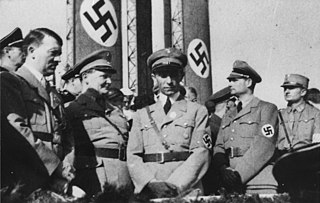
The Government of Nazi Germany was a dictatorship run according to the Führerprinzip. As the successor to the government of the Weimar Republic, it inherited the government structure and institutions of the previous state. Although the Weimar Constitution technically remained in effect until Germany's surrender in 1945, there were no actual restraints on the exercise of state power. In addition to the already extant government of the Weimar Republic, the Nazi leadership created a large number of different organizations for the purpose of helping them govern and remain in power. They rearmed and strengthened the military, set up an extensive state security apparatus and created their own personal party army, which in 1940 became known as the Waffen-SS.

Events in the year 1933 in Germany.
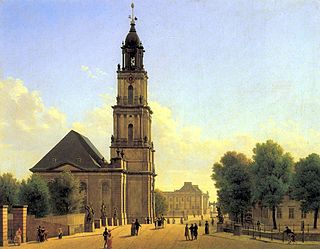
The Garrison Church was a Protestant church in the historic centre of Potsdam. Built by order of King Frederick William I of Prussia according to plans by Philipp Gerlach from 1730 to 1735, it was considered as a major work of Prussian Baroque architecture. With a height of almost 90 metres, it was Potsdam's tallest building and shaped its cityscape. In addition, the Garrison Church was part of the city's famous "Three Churches View" together with St. Nicholas Church and Holy Spirit Church. Damaged during the British bombing in World War II, the East German authorities demolished church in 1968. After the German reunification the Garrison Church is currently being rebuilt as a centre for remembrance and reconciliation.

Kaiser Wilhelm II abdicated as German Emperor and King of Prussia in November 1918. The abdication was announced on 9 November by Prince Maximilian of Baden and was formally enacted by Wilhelm's written statement on 28 November, made while in exile in Amerongen, the Netherlands. This ended the House of Hohenzollern's 500-year rule over Prussia and its predecessor state, Brandenburg. Wilhelm ruled Germany and Prussia from 15 June 1888 through 9 November 1918, when he went into exile. Following the abdication statement and German Revolution of 1918–19, the German nobility as a legally defined class was abolished. On promulgation of the Weimar Constitution on 11 August 1919, all Germans were declared equal before the law. Ruling princes of the constituent states of Germany also had to give up their monarchical titles and domains, of which there were 22. Of these princely heads of state, four held the title of king (König), six held the title of grand duke (Großherzog), five held the title of duke (Herzog), and seven held the title prince.
The German Combat Games were a national multi-sport event established in 1922 by the Deutscher Reichsausschuss für Leibesübungen under Carl Diem.

















